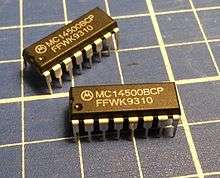1-bit computing
In computer architecture, 1-bit integers, memory addresses, or other data units are those that are 1 bit (1/8 octet) wide. Also, 1-bit CPU and ALU architectures are those that are based on registers, address buses, or data buses of that size.
| Computer architecture bit widths |
|---|
| Bit |
| Application |
| Binary floating-point precision |
|
| Decimal floating-point precision |

A serial computer processes data a single bit at a time. For example, the PDP-8/S was a 12-bit computer using a 1-bit ALU, processing the 12 bits serially.[1]
An example of a 1-bit computer built from discrete logic SSI chips is the Wang 500 (1970/1971) calculator[2][3] as well as the Wang 1200 (1971/1972)[4] word processor series of Wang Laboratories.
An example of a 1-bit architecture that was marketed as a CPU is the Motorola MC14500B Industrial Control Unit (ICU),[5][6] introduced in 1977 and manufactured at least up into the mid 1990s.[6] One of the computers known to be based on this CPU was the WDR 1-bit computer.[7] A typical sequence of instructions from a program for a 1-bit architecture might be:
- load digital input 1 into a 1-bit register;
- OR the value in the 1-bit register with input 2, leaving the result in the register;
- write the value in the 1-bit register to output 1.
This architecture was considered superior for programs making decisions rather than performing arithmetic computations, for ladder logic as well as for serial data processing.[5]
There are also several design studies for 1-bit architectures in academia, and corresponding 1-bit logic can also be found in programming.
Other examples of 1-bit architectures are programmable logic controllers (PLCs), programmed in instruction list (IL).
Several early massively parallel computers used 1-bit architectures for the processors as well. Examples include the Goodyear MPP and the Connection Machine. By using a 1-bit architecture for the individual processors a very large array (e.g. the Connection Machine had 65,536 processors) could be constructed with the chip technology available at the time. In this case the slow computation of a 1-bit processor was traded off against the large number of processors.
1-bit CPUs can now be considered obsolete; not many kinds have ever been produced, still as of 2020 many MC14500B chips are available from brokers for obsolete parts.[8][9]
References
- PDP-8/S Maintenance Manual (PDF). Digital Equipment Corporation. August 1969. p. 3–14.
- Wasserman, Katie (March 2006) [January 2004]. "LED calculators rule her house". Computer Collector Newsletter / Technology Rewind (Interview). Interviewed by Koblentz, Evan. Archived from the original on 2019-12-27. Retrieved 2017-05-20.
Probably my most favorite is the Wang 500. It's got several unique things about it: a very unusual ROM memory made of hundreds of long enamel-coated wires wrapped around iron cores; a super-fast single-bit CPU built out of SSI logic chips; and of course tons of really cool-looking colorful keys.
- Product Service - Schematic manual (PDF). Wang Laboratories, Inc. 1974. 03-0019-0. Archived (PDF) from the original on 2017-05-20. Retrieved 2017-05-20.
- Battle, Jim (2010-03-07). "Wang 1200 - Wang WP History". Archived from the original on 2017-05-21. Retrieved 2017-05-21.
- Gregory, Vern; Dellande, Brian; DiSilvestro, Ray; Malarkey, Terry; Smith, Phil; Hadley, Mike (1977). Motorola MC14500B Industrial Control Unit Handbook - Theory and Operation of a CMOS one-bit processor compatible with B series CMOS devices (PDF). Motorola Semiconductor Products Inc. 33-B78/8.0. Retrieved 2017-05-20. (NB. Also available in German language under the title "Motorola MC14500B Industrial Control Unit Handbuch - Theorie und Anwendung eines Ein-Bit-CMOS-Prozessors".)
- Industrial Control Unit MC14500B (PDF). Motorola CMOS Logic Data. Semiconductor Technical Data (revision 3 ed.). Motorola. 1995. pp. 306–313. Archived (PDF) from the original on 2017-05-20. Retrieved 2012-08-01.
- Ludwig, Volker; Paschenda, Klaus; Schepers, Heinz; Terglane, Hermann-Josef; Grannemann, Klaus; John, Burkhard; Komar, Hermann; Meinersen, Ludwig (1986). Fast alles über den WDR-1-Bit-Computer (PDF) (in German). Neuss & Recklinghausen, Germany: DATANorf. Archived (PDF) from the original on 2017-05-20. Retrieved 2017-05-20.
- "MC14500B Price & Stock". www.digipart.com. Retrieved 2019-11-04.
- "MC14500B". www.ebay.com. Retrieved 2019-11-04.
Further reading
- Mueller, Dieter (2005) [2004]. "The famous/infamous MC14500". Archived from the original on 2017-08-03. Retrieved 2018-07-18.
- Mueller, Dieter (2008). "MC14500 and arithmetic". Archived from the original on 2017-05-20. Retrieved 2018-07-18.
- Mueller, Dieter (2008). "A MC14500 modification". Archived from the original on 2017-03-20. Retrieved 2018-07-18.
External links
- Schembri, Thierry; Bizoirre, Sylvain; Boisseau, Olivier; Chauvaud, Pierre-Emmanuel. "WDR-1-Bit Computer". OLD-COMPUTERS.COM. Archived from the original on 2017-05-20. Retrieved 2017-05-20.